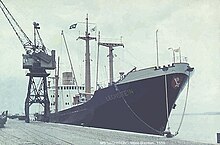Atlas works
The Atlas-Werke were a machine and shipbuilding company in Bremen . The company was founded in 1902 as a North German machine and armatures factory in Bremen by North German Lloyd .
history
The company was founded in 1902 as a valve factory and for the manufacture of auxiliary ship machinery such as steering gear , winches , pumps, drinking water generators and bulkhead locking systems. The Norddeutsche Maschinen- und Armaturenfabrik relocated its headquarters to the AG Weser site in 1905 , as this moved to Bremen- Gröpelingen . With the move, the old shipyard facilities were available and operations also began with the construction of new ships. In the beginning there were only small ships, but from 1919 new freighters of up to 1200 GRT were also built.
In 1911 the name was changed to Atlas-Werke. Despite the shipbuilding business, the focus of production was still on ship auxiliary machines.
In 1958, shipbuilding reached a high point with the construction of two motor ships ( Lechstein , Nabstein ) for North German Lloyd, each with a carrying capacity of 5350 t. The shipyard did not build significantly larger ships.
In 1965 the split and the mechanical engineering and the electronics were integrated into the works of Friedrich Krupp and in 1966 the Krupp-Atlas Maschinenbau was created together with the mechanical engineering company Kiel . The electronics sector became an independent Krupp Atlas Elektronik in Bremen, from the beginning of the 1990s, after the sale to the Bremer Vulkan STN Atlas Elektronik and after further transformations and investments 2,003 electronics Atlas emerged.
The small submarines Friedrich Schürer and Hans Techel of class 202 (100 t / 137 t submerged) were delivered to the German Navy in 1965/66 . In 1969 shipbuilding was stopped. Up to this point, over 400 ships had been delivered, around 30 of which were for the Navy.
Building program
Initially ships were mostly without drive as Light , various barges , tugs, barges and pontoons built. In 1906 the disinfection and fireboat Clayton vehicle A (23 GRT) was completed for the colony of German East Africa . The construction program changed from around 1914 onwards. Now more and more tour , tug and freight steamers were built. For the Hamburg Vulcan works created in 1915 torpedo boat - hulls and for Germaniawerft the hull for 1917 was U 156 delivered.
The traffic steamer Nordsee, delivered in 1914 and measured at 825 GRT for island service to Helgoland , was taken over by the Imperial Navy and used as a tender during World War I and used from 1921 to 1945 by the Reichsmarine and Kriegsmarine as an escort ship for speedboats and clearing boats.
Around 1920, a series of four 940 GRT freight steamers were delivered to J. Lauritzen, after which it was mainly German shipping companies that ordered small cargo ships of up to 1200 GRT. The Helgoland marine construction department and the Kriegsmarine each received two motor tugs with 100 GRT in 1938/39. Ten minesweepers were also delivered for the Kriegsmarine between 1942 and 1945 .
The last ships delivered included two suppliers with 499 GRT, including the shield tower for the DDG Hansa .

